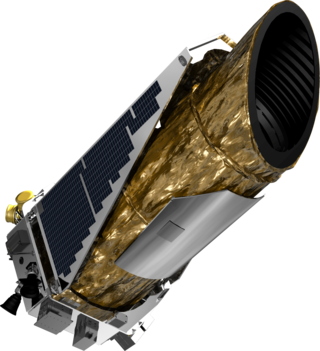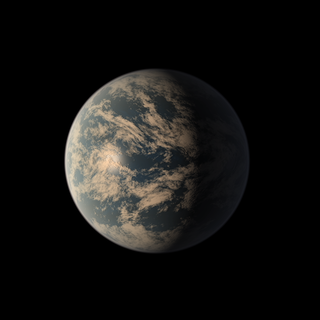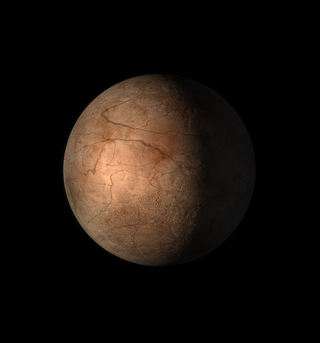Related Research Articles

An exoplanet or extrasolar planet is a planet outside the Solar System. The first possible evidence of an exoplanet was noted in 1917 but was not recognized as such. The first confirmation of detection occurred in 1992. A different planet, initially detected in 1988, was confirmed in 2003. As of 1 April 2023, there are 5,346 confirmed exoplanets in 3,943 planetary systems, with 855 systems having more than one planet. The James Webb Space Telescope (JWST) is expected to discover more exoplanets, and also much more about exoplanets, including composition, environmental conditions and potential for life.

The Kepler space telescope is a disused space telescope launched by NASA in 2009 to discover Earth-sized planets orbiting other stars. Named after astronomer Johannes Kepler, the spacecraft was launched into an Earth-trailing heliocentric orbit. The principal investigator was William J. Borucki. After nine and a half years of operation, the telescope's reaction control system fuel was depleted, and NASA announced its retirement on October 30, 2018.

An exomoon or extrasolar moon is a natural satellite that orbits an exoplanet or other non-stellar extrasolar body.

HD 189733 b is an exoplanet approximately 64.5 light-years (19.8 pc) away from the Solar System in the constellation of Vulpecula. Astronomers in France discovered the planet orbiting the star HD 189733 on October 5, 2005, by observing its transit across the star's face. With a mass 16.2% higher than that of Jupiter and a radius 13.8% greater, HD 189733 b orbits its host star once every 2.2 days at an orbital speed of 152.5 kilometers per second, making it a hot Jupiter with poor prospects for extraterrestrial life.

Transiting Exoplanet Survey Satellite is a space telescope for NASA's Explorer program, designed to search for exoplanets using the transit method in an area 400 times larger than that covered by the Kepler mission. It was launched on 18 April 2018, atop a Falcon 9 launch vehicle and was placed into a highly elliptical 13.70-day orbit around the Earth. The first light image from TESS was taken on 7 August 2018, and released publicly on 17 September 2018.

Transit-timing variation is a method for detecting exoplanets by observing variations in the timing of a transit. This provides an extremely sensitive method capable of detecting additional planets in the system with masses potentially as small as that of Earth. In tightly packed planetary systems, the gravitational pull of the planets among themselves causes one planet to accelerate and another planet to decelerate along its orbit. The acceleration causes the orbital period of each planet to change. Detecting this effect by measuring the change is known as transit-timing variations. "Timing variation" asks whether the transit occurs with strict periodicity or if there's a variation.

An exoplanet is a planet located outside the Solar System. The first evidence of an exoplanet was noted as early as 1917, but was not recognized as such until 2016; no planet discovery has yet come from that evidence. What turned out to be the first detection of an exoplanet was published among a list of possible candidates in 1988, though not confirmed until 2003. The first confirmed detection came in 1992, with the discovery of terrestrial-mass planets orbiting the pulsar PSR B1257+12. The first confirmation of an exoplanet orbiting a main-sequence star was made in 1995, when a giant planet was found in a four-day orbit around the nearby star 51 Pegasi. Some exoplanets have been imaged directly by telescopes, but the vast majority have been detected through indirect methods, such as the transit method and the radial-velocity method. As of 1 April 2023, there are 5,346 confirmed exoplanets in 3,943 planetary systems, with 855 systems having more than one planet. This is a list of the most notable discoveries.
Kepler-47 is a binary star system in the constellation Cygnus located about 1055 parsecs away from Earth. The stars have three exoplanets, all of which orbit both stars at the same time, making this a circumbinary system. The first two planets announced are designated Kepler-47b, and Kepler-47c, and the third, later discovery is Kepler-47d. Kepler-47 is the first circumbinary multi-planet system discovered by the Kepler mission. The outermost of the planets is a gas giant orbiting within the habitable zone of the stars. Because most stars are binary, the discovery that multi-planet systems can form in such a system has impacted previous theories of planetary formation.

Kepler-37, also known as UGA-1785, is a G-type main-sequence star located in the constellation Lyra 209 light years from Earth. It is host to exoplanets Kepler-37b, Kepler-37c, Kepler-37d and Kepler-37e, all of which orbit very close to it. Kepler-37 has a mass about 80.3 percent of the Sun's and a radius about 77 percent as large. It has a temperature similar to that of the Sun, but a bit cooler at 5,417 K. It has about half the metallicity of the Sun. With an age of roughly 6 billion years, it is slightly older than the Sun, but is still a main-sequence star. Until January 2015, Kepler-37 was the smallest star to be measured via asteroseismology.

Kepler-62f is a super-Earth exoplanet orbiting within the habitable zone of the star Kepler-62, the outermost of five such planets discovered around the star by NASA's Kepler spacecraft. It is located about 1200 light-years from Earth in the constellation of Lyra.

Kepler-438b is a confirmed near-Earth-sized exoplanet. It is likely rocky. It orbits on the inner edge of the habitable zone of a red dwarf, Kepler-438, about 472.9 light-years from Earth in the constellation Lyra. It receives 1.4 times our solar flux. The planet was discovered by NASA's Kepler spacecraft using the transit method, in which the dimming effect that a planet causes as it crosses in front of its star is measured. NASA announced the confirmation of the exoplanet on 6 January 2015.

TRAPPIST-1d, also designated as 2MASS J23062928-0502285 d, is a small exoplanet (about 30% the mass of the Earth), which orbits on the inner edge of the habitable zone of the ultracool dwarf star TRAPPIST-1 approximately 40 light-years (12.1 parsecs, or nearly 3.7336×1014 km) away from Earth in the constellation of Aquarius. The exoplanet was found by using the transit method, in which the dimming effect that a planet causes as it crosses in front of its star is measured. The first signs of the planet were announced in 2016, but it wasn't until the following years that more information concerning the probable nature of the planet was obtained. TRAPPIST-1d is the least massive planet of the system and is likely to have a compact hydrogen-poor atmosphere similar to Venus, Earth, or Mars. It receives just 4.3% more sunlight than Earth, placing it on the inner edge of the habitable zone. It has about <5% of its mass as a volatile layer, which could consist of atmosphere, oceans, and/or ice layers. Recent studies by the University of Washington have concluded that TRAPPIST-1d might be a Venus-like exoplanet with an uninhabitable atmosphere. The planet is an eyeball planet candidate.

TRAPPIST-1b, also designated as 2MASS J23062928-0502285 b, is a mainly rocky exoplanet orbiting around the ultra-cool dwarf star TRAPPIST-1, located 40.7 light-years away from Earth in the constellation of Aquarius. The planet was detected using the transit method, where a planet dims the host star's light as it passes in front of it. It was first announced on May 2, 2016, and between 2017 and 2018, more studies were able to refine its physical parameters.

TRAPPIST-1f, also designated as 2MASS J23062928-0502285 f, is an exoplanet, likely rocky but under a massive water-steam gaseous envelope at very high pressure and temperature, orbiting within the habitable zone around the ultracool dwarf star TRAPPIST-1 40 light-years away from Earth in the constellation of Aquarius. The exoplanet was found by using the transit method, in which the dimming effect that a planet causes as it crosses in front of its star is measured.

TRAPPIST-1g, also designated as 2MASS J23062928-0502285 g and K2-112 g, is an exoplanet orbiting around the ultra-cool dwarf star TRAPPIST-1 40 light-years away from Earth in the constellation Aquarius. It was one of four new exoplanets to be discovered orbiting the star using observations from the Spitzer Space Telescope. The exoplanet is within the optimistic habitable zone of its host star. It was found by using the transit method, in which the dimming effect that a planet causes as it crosses in front of its star is measured.

TRAPPIST-1h, also designated as 2MASS J23062928-0502285 h, is an exoplanet orbiting around the ultra-cool dwarf star TRAPPIST-1 39 light-years away from Earth in the constellation Aquarius. It was one of four new exoplanets to be discovered orbiting the star using observations from the Spitzer Space Telescope. Throughout 2017 and 2018, more studies were able to refine its physical parameters.
K2-155d is a potentially habitable Super-Earth exoplanet in the K2-155 system. It is the outermost of three known planets orbiting around the K-type star K2-155 in the constellation Taurus. It is one of 15 new exoplanets around red dwarf stars discovered by Japanese astronomer "Teruyuki Hirano" of the Tokyo Institute of Technology and his team. The team used data from NASA's Kepler Space Telescope during its extended K2 "Second Light" mission. K2-155d orbits near the so-called habitable zone of its system, and has the potential to host liquid water.
TOI-700 is a red dwarf 101.4 light-years away from Earth located in the Dorado constellation that hosts TOI-700 d, the first Earth-sized exoplanet in the habitable zone discovered by the Transiting Exoplanet Survey Satellite (TESS).
References
- ↑ "John Simon Guggenheim Foundation | Eric Agol" . Retrieved 2020-08-24.
- ↑ "| NASA Astrobiology Institute". astrobiology.nasa.gov. Retrieved 2020-08-24.
- ↑ "Eric Agol, UW Astronomy". faculty.washington.edu. Retrieved 2020-08-24.
- 1 2 "Agol, Eric – Department of Astronomy" . Retrieved 2020-08-24.
- ↑ Falcke, Heino; Melia, Fulvio; Agol, Eric (1 January 2000). "Viewing the Shadow of the Black Hole at the Galactic Center". The Astrophysical Journal. 528 (1): L13–L16. arXiv: astro-ph/9912263 . Bibcode:2000ApJ...528L..13F. doi:10.1086/312423. PMID 10587484. S2CID 119433133.
- ↑ Overbye, Dennis (10 April 2019). "Darkness Visible, Finally: Astronomers Capture First Ever Image of a Black Hole". The New York Times.
- ↑ "'Upside-down planet' reveals new method for studying binary star systems". UW News.
- ↑ Agol, E.; Steffen, J.; Sari, R.; Clarkson, W. (11 May 2005). "On detecting terrestrial planets with timing of giant planet transits". Monthly Notices of the Royal Astronomical Society. 359 (2): 567–579. arXiv: 2005.08922 . Bibcode:2005MNRAS.359..567A. doi:10.1111/j.1365-2966.2005.08922.x. S2CID 16196696.
- ↑ Cowan, N. B.; Agol, E.; Charbonneau, D. (1 August 2007). "Hot nights on extrasolar planets: mid-infrared phase variations of hot Jupiters". Monthly Notices of the Royal Astronomical Society. 379 (2): 641–646. doi: 10.1111/j.1365-2966.2007.11897.x .
- ↑ Knutson, Heather A.; Charbonneau, David; Allen, Lori E.; Fortney, Jonathan J.; Agol, Eric; Cowan, Nicolas B.; Showman, Adam P.; Cooper, Curtis S.; Megeath, S. Thomas (May 2007). "A map of the day–night contrast of the extrasolar planet HD 189733b". Nature. 447 (7141): 183–186. doi: 10.1038/nature05782 . PMID 17495920.
- ↑ Agol, Eric (April 2011). "Transit Surveys for Earths in the Habitable Zones of White Dwarfs". The Astrophysical Journal Letters. 731 (2): L31. arXiv: 1103.2791 . Bibcode:2011ApJ...731L..31A. doi:10.1088/2041-8205/731/2/L31. S2CID 118739494.
- ↑ Ashley Strickland. "Giant planet found orbiting a dead white dwarf star". CNN.
- ↑ "UW astronomer helps discover planet 1,200 light years from Earth". king5.com.
- ↑ "Edmonds astronomer plays key role in discovery of two moonless planets". My Edmonds News. 7 July 2012.
- ↑ "Astronomers discover five-planet system with most Earth-like exoplanet yet". UW News. Retrieved 2020-08-31.
- ↑ Will Mari. "Life on Kepler-62f? How a UW astronomer found a tantalizing new world". geekwire. Retrieved 2020-08-31.
- ↑ "The UW connection to an amazing astronomical discovery". Q13 FOX. 23 February 2017.
- ↑ "UW astronomer Eric Agol assists in new seven-planet NASA discovery using 'distracted driving' technique". UW News. Retrieved 2020-08-24.
- ↑ "UW astrophysicist played role in discovery of new planets". king5.com. Retrieved 2020-08-31.
- ↑ Foreman-Mackey, Daniel; Agol, Eric; Ambikasaran, Sivaram; Angus, Ruth (9 November 2017). "Fast and Scalable Gaussian Process Modeling with Applications to Astronomical Time Series". The Astronomical Journal. 154 (6): 220. arXiv: 1703.09710 . Bibcode:2017AJ....154..220F. doi:10.3847/1538-3881/aa9332. S2CID 88521913.
- ↑ "UW astrophysicist played role in discovery of new planets". king5.com.
- ↑ "TRAPPIST-1's Seven Earth-Sized Planets Are Likely All Made Of The Same Stuff". IFLScience.
- ↑ "The 7 Rocky TRAPPIST-1 Planets May Be Made of Similar Stuff". Jet Propulsion Laboratory .
- ↑ "Interview with Ian Agol" (PDF). Notices of the American Mathematical Society . 63 (1): 24. January 2016.
- ↑ "Alan Agol". Marin Independent Journal . October 5, 2005.